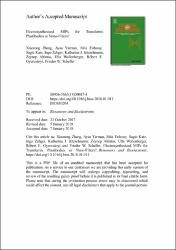Electrosynthesized MIPs for transferrin: Plastibodies or nano-filters?

View/
Access
info:eu-repo/semantics/openAccessDate
2018Author
Zhang, XiaorongYarman, Aysu
Erdossy, Julia
Katz, Sagie
Zebger, Ingo
Jetzschmann, Katharina J.
Scheller, Frieder W.
Metadata
Show full item recordAbstract
Molecularly imprinted polymer (MP) nanofilrns for transferrin (Trf) have been synthesized on gold surfaces by electro-polymerizing the functional monomer scopoletin in the presence of the protein target or around pre-adsorbed Trf. As determined by atomic force microscopy (AFM) the film thickness was comparable with the molecular dimension of the target. The target (re)binding properties of the electro-synthesized MIP films was evaluated by cyclic voltammetry (CV) and square wave voltammetry (SWV) through the target-binding induced permeability changes of the MIP nanofilms to the ferricyanide redox marker, as well as by surface plasmon resonance (SPR) and surface enhanced infrared absorption spectroscopy (SEIRAS) of the immobilized protein molecules. For Trf a linear concentration dependence in the lower micromolar range and an imprinting factor of similar to 5 was obtained by SWV and SPR. Furthermore, non-target proteins including the iron-free apo-Trf were discriminated by pronounced size and shape specificity. Whilst it is generally assumed that the rebinding of the target or of cross-reacting proteins exclusively takes place at the polymer here we considered also the interaction of the protein molecules with the underlying gold transducers. We demonstrate by SWV that adsorption of proteins suppresses the signal of the redox marker even at the bare gold surface and by SEIRAS that the treatment of the MIP with proteinase K or NaOH only partially removes the target protein. Therefore, we conclude that when interpreting binding of proteins to directly MIP-covered gold electrodes the interactions between the protein and the gold surface should also be considered.
















